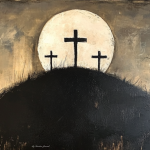One of the most vital questions for Christians is how we can be certain that our faith is grounded in truth rather than myths or fabrications. In 2 Peter 1:16-21, the Apostle Peter directly addresses this concern. He assures believers of the reliability and divine origin of both the apostolic testimony and the prophetic word, affirming that our faith stands on a firm foundation. This passage serves as a powerful reminder of the truth, reliability, and transformative nature of God’s Word.
Understanding Peter’s Message in 2 Peter 1:16-21
Peter wrote his second epistle to warn Christians about false teachers who were distorting the gospel. He makes it clear that the story of Jesus Christ is not a cleverly crafted myth but a truth rooted in eyewitness testimony and divine revelation. This distinction is crucial to the Christian faith, as it affirms that the apostles were direct witnesses to Christ’s majesty and power.
Peter declares in 2 Peter 1:16:
“For we did not follow cleverly devised myths when we made known to you the power and coming of our Lord Jesus Christ, but we were eyewitnesses of His majesty.”
This statement is significant. Peter draws a clear line between fabricated stories and the gospel truth. His use of the Greek word “ἐπόπται” (epoptai)—meaning eyewitnesses—emphasizes firsthand experience. He insists that his message is based on personal observation rather than hearsay or imagination.
The Power of Eyewitness Testimony in 2 Peter 1:16
Peter’s emphasis on eyewitness testimony is key to understanding the authenticity of his claims. The Greek term epoptairefers specifically to someone who has seen an event firsthand. The New Testament consistently upholds this principle, highlighting that the apostles and early followers of Jesus personally witnessed His life, teachings, miracles, death, and resurrection.
In particular, Peter’s testimony points to the Transfiguration—an event described in Matthew 17:1-8, Mark 9:2-8, and Luke 9:28-36. During this moment, Peter, along with James and John, saw Jesus in His glorified state on a high mountain. They not only witnessed His divine radiance but also heard God’s voice declaring:
“This is My beloved Son, with whom I am well pleased.”
This profound encounter left a lasting impact on Peter. Years later, he referenced it as confirmation that the gospel is rooted in historical reality, not myth (2 Peter 1:16-21). His firsthand experience, recorded alongside other apostolic accounts, provides compelling evidence of the truth of Christ’s divine nature.
Why We Can Trust Peter’s Testimony as Authentic
Peter’s testimony in 2 Peter 1:16-21 is not an isolated account. The Transfiguration is documented in three separate Gospels, demonstrating consistency across multiple authors. This alignment reinforces the authenticity of the apostolic witness.
Additionally, the apostles’ unwavering commitment to spreading the gospel—despite facing persecution, imprisonment, and even martyrdom—supports the truthfulness of their testimony. Historically, people do not willingly endure torture and death for something they know to be false. Their dedication, even under extreme hardship, is strong evidence that they truly believed in what they had witnessed.
Here are three key reasons why Peter’s testimony is trustworthy:
- Consistency Across Multiple Authors
- The same core truths about Jesus’ life, death, and resurrection appear across the New Testament, showing that the apostolic accounts were not fabricated but shared experiences.
- The Apostles’ Transformation
- After the resurrection, the apostles went from fearful followers to bold proclaimers of the gospel. This radical change is difficult to explain unless they had genuinely witnessed Christ’s resurrection and majesty.
- External Corroboration
- Early Christian creeds, non-biblical historical writings, and archaeological discoveries support the events described in the New Testament, further confirming that it was not a mere fabrication.
The Prophetic Word Confirmed by Apostolic Experience
In 2 Peter 1:19, Peter shifts focus from his personal testimony to the prophetic Scriptures:
“And we have the prophetic word more fully confirmed, to which you will do well to pay attention as to a lamp shining in a dark place, until the day dawns and the morning star rises in your hearts.”
Here, Peter emphasizes that Old Testament prophecies about the Messiah have been fulfilled through Jesus’ life, ministry, death, and resurrection. These prophecies serve as an additional confirmation of the truth of the Christian message.
Some of the key messianic prophecies fulfilled in Jesus include:
- The Virgin Birth (Isaiah 7:14) → Fulfilled in Matthew 1:22-23
- The Suffering Servant (Isaiah 53) → A description of Christ’s sacrificial death on the cross
- The Davidic King (2 Samuel 7:12-13) → Jesus’ genealogy and eternal kingship
The apostles recognized that these prophecies found their ultimate fulfillment in Jesus. Thus, Peter provides a double assurance: the gospel is verified both by eyewitness experience and prophetic fulfillment.
Early Christian Sources Support Peter’s Claims
The early Christian community further affirms Peter’s testimony. Early Christian creeds—written shortly after Jesus’ resurrection—summarize the beliefs and eyewitness accounts of the apostles. One key example is 1 Corinthians 15:3-8, where Paul recounts Jesus’ death, burial, and resurrection, listing Peter as one of the eyewitnesses.
Beyond Christian sources, even non-Christian historians, such as Josephus and Tacitus, mention Jesus and the early Christian movement. These historical references reinforce that Jesus was a real figure and that His followers truly believed in His divinity and resurrection.
Key Message: The Reliability of Scripture and Apostolic Testimony
At its core, 2 Peter 1:16-21 teaches that the Christian faith is grounded in historical evidence, eyewitness testimony, and divine inspiration. The apostles’ accounts are not based on myths but on real, personal encounters with Christ. When combined with prophetic fulfillment, this provides believers with unwavering assurance in the reliability of God’s Word.
Practical Application: How This Truth Impacts Daily Life
Understanding the truth of 2 Peter 1:16-21 has real-world significance for believers today. Here are three ways to apply this passage:
- Deepen Your Knowledge of Scripture
- Regularly study the Bible to strengthen your faith and understanding of God’s truth.
- Boldly Share Your Faith
- Just as the apostles did, share the gospel with confidence, knowing it is based on historical reality.
- Trust in God’s Word During Hard Times
- Lean on Scripture for guidance, comfort, and strength, trusting in its divine authority.
Journal Prompt for Reflection
In your My Devotion Journal, take time to reflect on a moment when God’s Word provided you with guidance or comfort. How does understanding the reliability of Scripture impact your faith today? Write down ways you can deepen your trust in God’s Word and apply its truths in your daily life.
Conclusion: Standing on the Foundation of God’s Word
In 2 Peter 1:16-21, Peter provides a profound affirmation of the truth and reliability of the Christian faith. Through the apostles’ eyewitness testimony and the fulfillment of prophecy, he assures believers that our faith is grounded in reality, not myth.
Let us hold fast to this truth and allow it to shape and transform our lives. By trusting in the reliability of Scripture, we affirm that our faith is not blind but rooted in the unshakable Word of God. May this assurance inspire you to live boldly and faithfully, knowing that God’s Word is a firm foundation for life.






